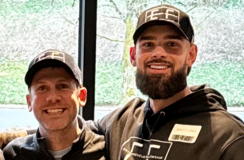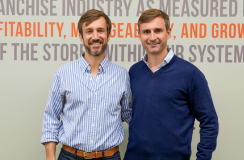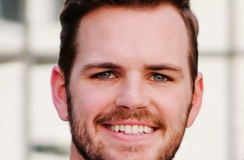elcey Lehrich and his business partner, Justin Scheeff, ran offline businesses together for six years before transitioning to e-commerce.
While those endeavors brought in enough to support them and their families, it was essentially just the Kelcey and Justin show. “We were more self-employed partners than we were business owners,” Kelcey says.
That changed when they bought their first e-commerce company, an outdoor gear brand specializing in knives called Steel River, in 2017. Today their holding company, 365 Holdings, includes a total of six e-commerce brands.
Timing and opportunity made a big difference in what the company would become. Although their home services and other offline businesses had not been especially profitable, they finally had the liquidity to qualify for a Small Business Administration (SBA) loan, which they used to acquire Steel River.

In their search for a brand to purchase, they focused on tech broadly — not e-commerce specifically. When the chance to acquire Steel River presented itself however, they decided to take the leap. One difference from their previous businesses was that Steel River came with a team, and overall Kelcey and Justin were comfortable with what Kelcey calls that “first meaningful acquisition.” It didn’t matter whether Steel River was an online or offline business.
Just three months later, they acquired their second brand, also in e-commerce, and Kelcey started seeing more possibilities in e-commerce: “I'm just generally bullish on people buying stuff on the internet,” he says in the episode.
A couple of months later, 365 Holdings filed as an LLC with the plan to acquire additional e-commerce companies.
On this episode, Kelcey describes what makes for a good e-commerce acquisition and how to evaluate whether an e-commerce company might be right for you. He also talks about the value of using an SBA loan to acquire a larger entity rather than just getting your feet wet with a smaller e-commerce acquisition.
Check out:
✳️ Top takeaways from the episode
✳️ Episode highlights with timestamps
Acquisition Entrepreneur: Kelcey Lehrich
💵 What he acquired: After working on a few offline businesses but never really hitting it big, Kelcey, who has an M&A background, and his business partner’s search for a tech company ended with their acquisition of an e-commerce brand. They created Akron, Ohio-based 365 Holdings, which now has a total of six brands in its portfolio.
💡 Key quote: “After that first meaningful acquisition happened, I began to think more about e-commerce as the platform of the future and less about industry diversity. Once we found e-commerce there was no looking back.”
👋 Where to find him: Twitter | LinkedIn

Acquisition Tips From The Episode
Top takeaways from this week’s conversation
🛒 When buying an e-commerce company, weigh DTC vs. Amazon.
Generally speaking, there are two types of e-commerce companies: Amazon and DTC businesses. Amazon is a turnkey solution for those who would rather outsource the logistics, but the margins are lower and the competition is fierce. Plus, there’s not much you can do to increase demand. As Kelcey says, “Amazon businesses are in a rented land ecosystem where you’re competing for market share.”
DTC e-commerce stores require a heavier lift because you’re responsible for customer service and supply chain like you would be with an Amazon store, but you also have to do more on the marketing side. DTC businesses offer the opportunity to try more growth initiatives.
💡 For e-commerce businesses, acquisition channels don’t always cross-pollinate.
You’ll want to consider how the e-commerce company you’re thinking about buying acquires its customers. Is it a mass-market demand capture business that can rely on SEO or pay-per-click? Or, is it a demand creation business that will need to generate interest from customers from Instagram, TikTok, etc.
One thing Kelcey cautions is that you can’t always take an acquisition channel that has worked with one brand and apply it to another. Though brokers often suggest you can do this, Kelcey hasn’t found it to be the case.
💰 If you’re set on e-commerce, you’ll learn a lot more by acquiring a $500,000 business instead of a microbusiness.
If you just want to dip your toe in the water with e-commerce, Kelcey recommends going the Amazon route or buying a brand for around $20k on MicroAcquire or Flippa. That’ll teach you to run ads, source products and fulfill orders, but it won’t give you true insight into how to scale an e-commerce company.
Kelcey thinks you’ll learn a lot more by using the same amount of money towards a downpayment on an SBA loan and buying a larger e-commerce business. “I think that is a meaningfully different experience,” he explains, comparing it to buying a condo to rent out on Airbnb versus buying an entire apartment building.
Episode Highlights
Inflection points from the show
[1:52] Humble beginnings: During their first six years working together, Kelcey and his business partner, Justin, had a series of “scrappy” offline businesses.
[3:10] The pivot: In 2017, the partners bought their first e-commerce business, knife and outdoor gear manufacturer Steel River, which came with a team and became the foundation of 365 Holdings.
[3:28] The first expansion: They bought their second business a few months later (and have since sold it). With Kelcey in the “visionary” role and Justin as “the integrator,” they oversee the management of 365’s current six-business portfolio by loosely following the Entrepreneurial Operating System (EOS) framework.
[5:01] A dream realized: Having the liquidity to qualify for a Small Business Administration (SBA) loan for the first time made it possible for Kelcey and Justin to acquire Steel River. They spent six to nine months searching broadly for a tech business, but ultimately landed on e-commerce.
[6:06] Baby steps: The first business Kelcey and Justin bought when they were fresh out of college cost them just $10,000.
[6:42] Platform decisions: Kelcey and Justin didn’t set out to focus on e-commerce specifically, but after their first acquisition went pretty smoothly, there was no looking back. “After that first meaningful acquisition happened, I began to think more about e-commerce as the platform for the future and less about industry diversity,” Kelcey says, adding that the duo saw the core competencies built around the first brand as something they could repeat and scale for others.
[8:50] On the decisions to create a holding company: About five months after the first acquisition, 365 became an LLC. By this time, Kelcey and Justin had already acquired a second brand, and for tax, legal and practical reasons — like creating a new email address each time they made an acquisition — a single holding company just made sense.
[10:00] Finding your business sweet spot: When considering your “business-buyer fit,” Kelcey says it’s about having a solid understanding of your skill sets, strengths, and beliefs. He distinguishes between the market and the asset: “Maybe e-commerce in general is not for you, but you can find an asset in e-commerce that you’d love to own.”
[10:47] E-commerce considerations: The e-commerce world can be broadly divided into Amazon and direct-to-consumer businesses.
[12:51] One size doesn’t fit all: Kelcey’s early e-commerce experience was a steep learning curve. “I didn't understand that we would be buying businesses that were probably captive to one, maybe two channels … Just because one business has a big Facebook presence, doesn't mean you can take every last tactic from that playbook and move it across those brands,” he says.
[14:39] Amazon — it’s a jungle: “Amazon is e-commerce with training wheels,” says Kelcey. Simply selling on the platform comes with a lot of perks like demand you can harness and Amazon’s logistics machine. But there are drawbacks like fake reviews and the realities of dealing with big tech.
[17:27] Acquisition entrepreneurship outlook: Kelcey is bullish on e-commerce, but predicts that “operational excellence” will become more challenging. Though he’s betting on e-commerce, he sees opportunity with sweaty offline businesses — plumbing, HVAC and other services. “As the Boomer generation retires, these become great assets to hand over.”
[20:42] Cashflow acquisition opportunity: Kelcey looked at buying FedEx routes and views them as a great business to operate, but a tough business to grow. While it didn’t align with his goals, he says it could be a great small business opportunity if you’re in the market for something stable to run over the next decade.
[24:14] Finding talented acquisition entrepreneurs: 365 offers an Entrepreneur in Residence program, which helps the company recruit high-performance people to work in the business while offering them the opportunity to develop their skills and execute an acquisition search. Kelcey says the program is loosely based on the traditional search fund model.
[28:56] Get your feet wet: If you’re thinking about getting into e-commerce, you could buy a small e-commerce brand through a platform like MicroAcquire or get started on Amazon. Kelcey recommends taking the same money you’d use for that kind of acquisition and instead use it as a downpayment on an SBA loan for a larger amount. “There’s a meaningful difference. It’s the difference between buying a condo and buying an entire apartment building to use as an Airbnb property.”
[31:30] The litmus test for acquisition: If you’re a great operator, acquisition could be a good fit. Kelcey recognizes that buying a business and starting a business take different skill sets and admits that 365 has tried starting companies and it has never worked out.
Links & Mentions
✅ Entrepreneurial Operating System
✅ U.S. Small Business Administration (SBA) 7(a) Loan Program




%20-%20thumbnail.png)



%20-%20thumbnail.png)

.png)




%20-%20thumbnail.png)















%20-%20thumbnail.png)











































































